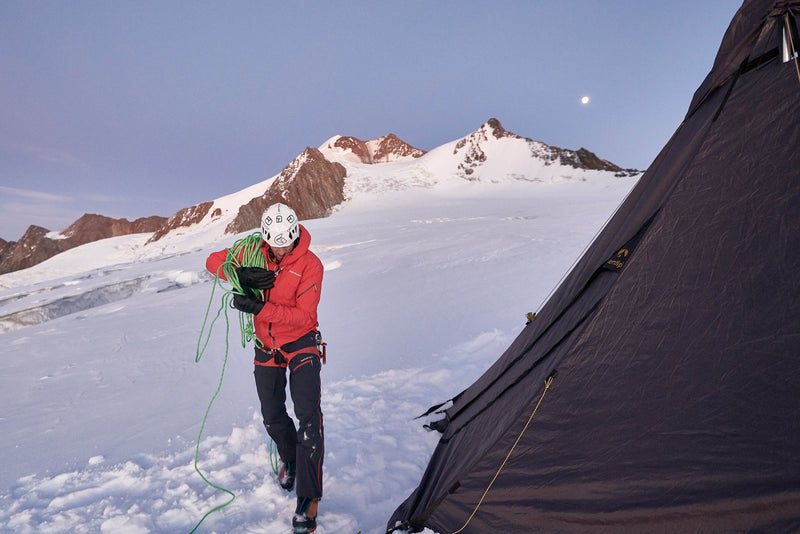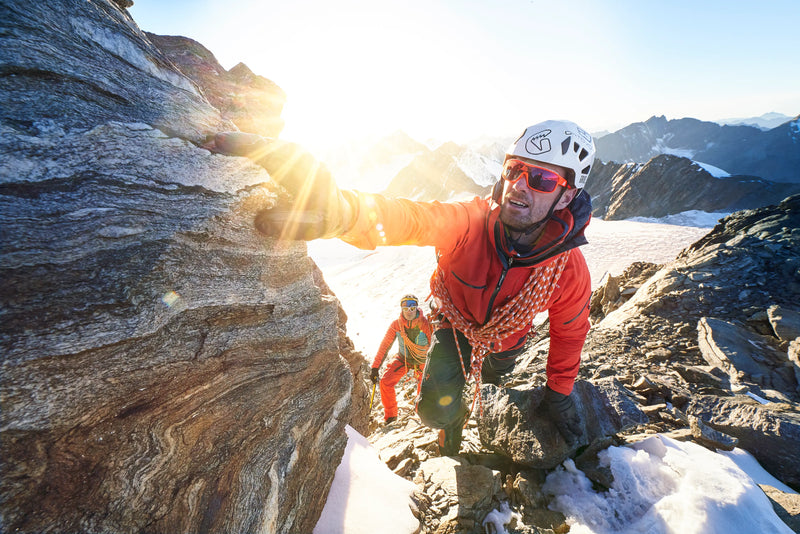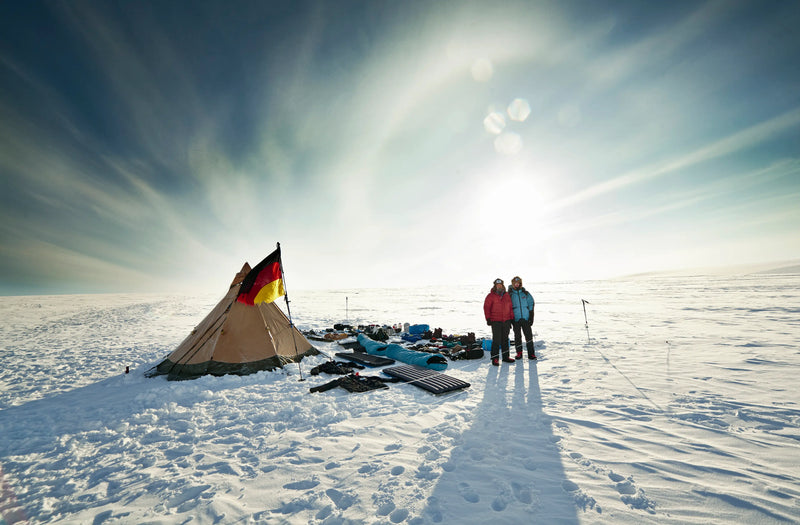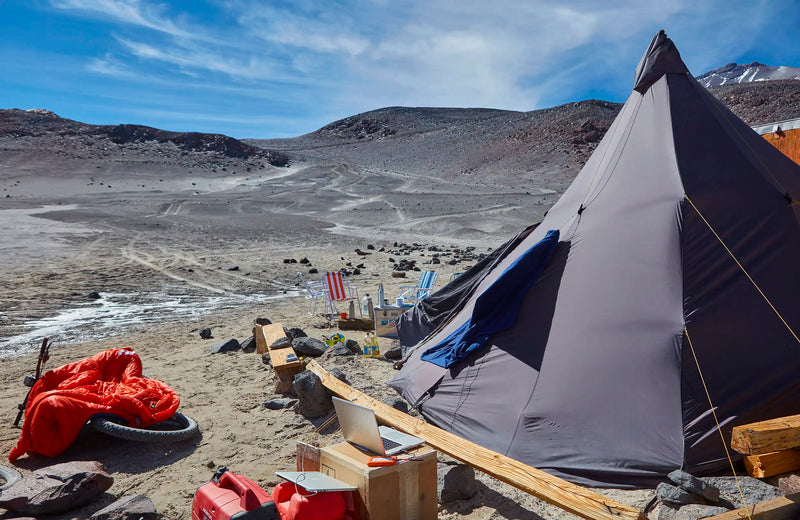It was the first day of the trip, adventurer Mike Fuchs and his friend Eric Folz had just a couple of hours before been dropped off as far north as they could possibly come in Svalbard when they saw them. Two polar bears, one mother and its cub. A situation that could become deadly if the bears decided to have a closer look on their new visitors.
“We had a wonderful time, with a lot of nice hiking tracks. I had never really slept in the wild before, but from this day on I knew that this was what I wanted to do. Since then I have invested a lot of time in finding new hiking trails and new places to discover”, says Mike.
From there he went on a lot of different hiking trips around Europe, doing more difficult treks for each trip that he took. He also found an interest in mountaineering and reached the summit of mountains in and around the Alps, the Iberian mountains in Spain and on the Canary Islands. “I never want to stop exploring the world, there is so much to see out there”, says Mike.
As a day job, Mike Fuchs is a photographer and works mostly with portraits and architectural photography. As his hobby with the outdoor activities grew he started to wonder if he could combine it with his job.
As with many new found hobbies Mike got very interested in finding the right gear for his trips. He started contacting outdoor equipment companies and found clients that sponsored in return for photos of their products in a stunning environment. Around the same time he also got an opportunity to go on a life changing expedition.
“I had the chance to be a part of an expedition that would go from Paris to New York”, says Mike.

"I got all this equipment and now the expedition is cancelled, what could I do?"
Mike Fuchs
The best laid plans
“From this day on I worked more and more with outdoor equipment clients and with my passion to give other people an idea what is out there. It is not only the cities and your safe house, there is something else out there too”, Mike says.
He soon discovered that there is a lot of nature and outdoor photographers, and he had to try something else to stand out. He put his focus to authentic winter experiences and to go bigger and more extreme for every journey that he made. The first one was a trip to Hardangervidda in Norway.


"For winter treks you need so much space, you can’t only have equipment in a backpack if you really want go out there. You need a very rough tent to handle these conditions."
Mike Fuchs
Finding reliable gear
“I tried catching it but it was so fast and rolling through the snow, the wind was about 30 to 40 kilometers per hour, it was impossible”, says Mike.
The mattress that he still had with him was very thin, only about five millimeters thick. He tried sleeping on it for a few more nights, but it was way too thin and could not keep him warm enough. It got too cold and he had to take the difficult decision to turn back and end his first ever winter expedition early.
“From this day on I always make sure that everything I have in my equipment is secured by carabiners or ropes. I do not want to lose any mattresses again, it is one of the most important things for a winter expedition”, says Mike.
After this journey he started to think even more about the gear that he uses on his expeditions. As he was planning the trip to Svalbard he knew that he would need a much rougher tent. This is how he came into contact with Tentipi.
“For winter treks you need so much space, you can’t only have equipment in a backpack if you really want go out there. You need a very rough tent to handle these conditions. When there is a thunderstorm in the summer it lasts for maybe a couple of hours, but a snow storm in the winter can last for days, then you need a good shelter”, says Mike.
Face to face with polar bears
Mike got contacted by his engineering friend Eric Folz, who was working on creating a new lightweight material for the airline and car industries. Out of this material they created pulka-sleds and wanted to stress test them in a harsh environment, and that they could find in Svalbard. Mike’s job was to document the journey and create content around the new material that Eric Folz had created.
It was a three week expedition that went from the northernmost part of Svalbard, back to the main village of Longyearbyen, a 250 kilometer journey. It was a dangerous route over glaziers and deep crevasses so that they really had to concentrate on where they put their feet. On this trip Mike brought a Tentipi Safir 5 cp as their home during their expedition. He had heard a lot about Tentipi and contacted CEO and founder Bengt Grahn who suggested that the Safir-model would work well for their needs in Svalbard.
The bear-scare on the first day of the trip made the two-man team a little bit apprehensive, if they would make it through the expedition.
“When it was my time to sleep I was laying there wondering what would happen if a polar-bear came through our and camp and if the tent would withstand it. Probably not, but the material gave me a little more sanity because I knew that if something would break it would be the central-pole and not the canvas”, says Mike.
The polar bears were not interested in the two explorers and they did not see any more of them for the rest of the trip. Instead it was the ice and the sky. For days and days it was the only thing that was in front of their eyes.
“There are no cars, there are no other people, and there is no noise when you reduce everything to this very low impact. I really like that feeling, it is like meditation. It is only you and the nature”, says Mike.
They made it back to Longyearbyen in time after three weeks with no accidents, and the gear that they brought was intact. The expedition had been a success.


Volcanic adventures
Throughout the following years Mike Fuchs has been on several exciting expeditions, such as the climbing of one of the highest mountains in the world, Pik Lenina, 7,134 meter above the sea located in the Pamir Mountains in central Asia. But it is another trip that has a very special place in his heart, a biking expedition up the highest volcano in the world, Ojos del Salado in Chile.
It was a three man team with a goal to reach the summit of 6,890 meters on bike, and they were followed by a camera team from a large German broadcaster. It was a journey hundreds of kilometers that took the team through many different landscapes, through the Atacama desert that have never seen rain, through high altitude passages where they one day were at 4,000 meters and the next day down at 2,000 meters altitude.
“It was a tough expedition with a lot of sweat, the temperatures were incredibly hot”, says Mike.
They tried to reach to top of the volcano with their bikes, but it was not possible. The weather stopped them at about 6,000 meters altitude. Normally it is not much precipitation in the desert, but this year the mountain region got a lot of snow.

Finding new friendships
The three members of the team did not know each other before the trip, they were from different backgrounds and from different generations. During the expedition they all slept in an Onyx 9 light, a lightweight tent with plenty of space.
“We found great friendship out there, when we were so very close to each other for weeks and weeks. We were three completely different people but managed to build a team in such a short time. Much of that was possible because we had a big tent”, says Mike.
After they finished cycling for the day, a lot of time was spent in the tent. Time getting to know each other, planning for the next day’s journey and production meetings with the camera crew. They also met a few other mountain climbers that they could provide some shelter to or cook a meal together.
“It was huge of course for only three or four people, but I would say we needed all the space we had. There was plenty of room for all the equipment and for doing repairs on the bike”, says Mike.
"It is a compromise between having a good night’s sleep, or having a night where you might wake up every two hours to make sure that the tent is still intact."
Mike Fuchs
Prioritizing gear
Mike had previously climbed Peak Lenin with an Onyx 5 light and he felt like it worked out well for that trip, when he needed to carry everything with him. For the Ojos del Salado trip he knew that it would not be possible for their escort car to go all the way up the top of the volcano. They needed to be able to carry their gear by themselves, and went with the lightweight option.
When it comes to what gear Mike uses and what goes into when planning for a trip it is much about figuring out where to save weight on the gear and what to prioritize. But, it could be okay not to have the most lightweight tent on the market, just to get that extra comfort for charging ones batteries.
“It is a compromise between having a good night’s sleep, or having a night where you might wake up every two hours to make sure that the tent is still intact. I would say that it’s a good investment to have the two kilos extra weight on the tent that make you well rested for the next day”, says Mike.
Family time
Future adventure
Mike does have plans to go out on new adventures again. It stills bugs him that he could not be able to pass the Bering Strait traverse all those years ago. The new plan is to go back but now travel the entirety of the North West passage on an inflatable catamaran.
“You can pack the whole sailing boat in your car, it is very stable and I have some experience from sailing in winter when it is under zero degrees and in snowfall. I am ready for the expedition and I can’t wait for the borders to open”, says Mike.
All photos courtesy of Mike Fuchs






